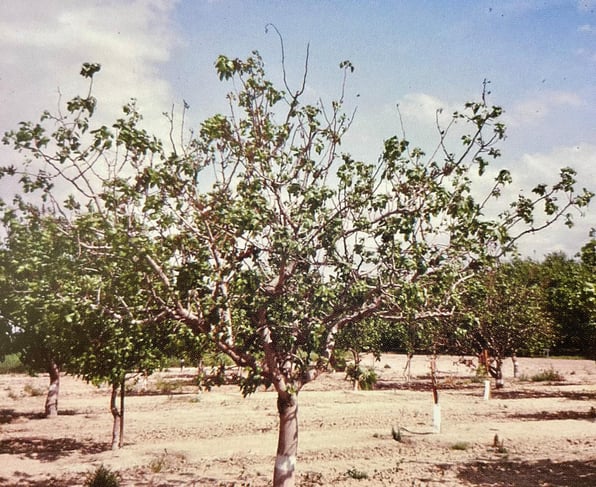Zinc Management in Pistachios: Foliar Sprays Postbloom


Zinc in the soil
Plant uptake of zinc is reduced in soils with pH values 7 and greater. High pH values are often found in calcareous soil in pistachio orchards in California. Application of fertilizers that can acidify the soil may reduce soil pH and increase the availability of zinc. Among these fertilizers are ammonium sulphate, ammonium phosphate, urea, and elemental sulfur. Low levels of organic matter and high levels of magnesium and phosphorus in the soil can also reduce zinc uptake. Because alkaline soils are more susceptible to zinc deficiency, fertigating with non-chelated zinc in those conditions is not very effective.
Zinc deficiency symptoms in pistachio
Zinc deficiency symptoms appear early in the season, with the delay in the opening of vegetative and flower buds that can take up to a month. Symptoms often resemble cold injury. The terminal leaves are small, chlorotic, and severe deficiency causes dieback of young terminal shoots and extremely short internodes that result in a rosetting effect. Other symptoms include poor fruit set, small, reddish, and excessive blank nuts. Optimal zinc leaf tissue concentration ranges from 10-15 ppm while the critical level is 7 ppm.
Zinc deficiency in pistachios. Source: Nutrient Deficiency in Pistachios Guide Booklet. UC-Davis Fruit & Nut Research & Information Center.
Zinc foliar sprays post-bloom
During periods of high nutrient demand or when soil conditions during the growing season reduce the availability of soil nutrients, one alternative is the application of foliar zinc. Foliar fertilization is a rapid and efficient way to improve crop nutrient status. The best time for foliar application of zinc is post-bloom, at 50% leaf expansion, in late April and early May. During that time leaves have a cuticle thin enough for nutrient uptake and sufficient surface area that the amount of nutrient taken up is large enough to enhance tree performance. Fall applications (late October or early November), just before leaf drop, have not been proven to improve the nutrient status of trees.
Foliar sprays post-bloom with zinc sulfate 36 % (2 lbs. per acre) is recommended. It is also suggested to adjust the solution with citric acid to pH 4.5 to improve nutrient solubility and absorption. Since zinc is highly immobile in pistachio trees, it is important to note that in-season sprays correct deficiency on new growth, not old.
It is always recommended to check for zinc symptoms in spring. However, the onset of zinc deficiency will occur during mid-late season. Therefore, it is extremely important to do annual soil and leaf sampling to get an accurate picture of the zinc needs and uptake in the orchard.
Zinc is a micronutrient that is commonly deficient in young and mature pistachio orchards. Zinc is essential for cell elongation and growth, pollen development, flower bud differentiation, and fruit set. Zinc is very immobile within the tree, and as a result symptoms are often found in young tissue. Reduced yields are the primary symptom of zinc deficiency.
